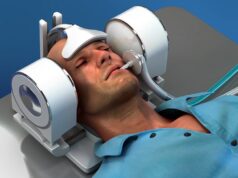
Enabling more clinicians to assess cerebral blood flow characteristics and detect neurological diseases such as stroke using robotic ultrasound technology could help to facilitate more efficient patient triage and intervention. Thomas Devlin, (Erlanger Health System, Chattanooga, USA) looks at how expanding use of ultrasound could positively impact the diagnostic landscape for neurological diseases.
As a neurologist based in Tennessee, one of the eleven states in the stroke belt where stroke prevalence is significantly above the national rate, we see an average of over 2400 strokes per year.
Stroke affects more than 795,000 people in the USA and every four minutes someone dies from stroke. Neurological diseases represent a significant cost burden to the healthcare system amounting to nearly US$800 billion annually, with stroke, traumatic brain injury, migraine and Alzheimer’s accounting for more than US$438 billion of that cost.
Despite the high cost of stroke and the great strides in treatment over the past three years, there is still a great need for an accurate pre-hospital assessment tool for stroke. Most emergency medical services (EMS) screening tools do not adequately assess stroke severity and demonstrate poor sensitivity in distinguishing patients with large vessel occlusion (LVO) stroke which is critical to determining the treatment facility to take a given patient. Less than 5% of stroke patients qualify for intervention because they are not brought in early enough.
Transcranial Doppler ultrasound technology is an established method to detect neurological diseases such as acute ischaemic stroke. It is relatively inexpensive, and provides non-invasive real-time measurements of blood flow characteristics. One drawback, however, is that this assessment technique employs expert technicians (sonographers, who are currently understaffed, to globally support the volume of patients needed for rapid stroke detection and management.
To address limitations in assessing neurological diseases, we initiated a clinical study using a recently FDA-cleared robotic ultrasound device, known as the Lucid Robotic System, to determine its efficacy in detecting neurological diseases.
The Lucid Robotic System is a combination of the Lucid M1 Transcranial Doppler Ultrasound System, an all-in-one neurovascular ultrasound device designed to non-invasively measure and display brain blood flow information, and the NeuralBot, a robotically assisted headset which automatically adjusts orientation and position under the guidance of a healthcare professional.
We presented results from the first phase of the study, at the 10th Annual Society of Vascular and Interventional Neurology meeting, which demonstrated that the technology platform was accurate with >94% area under the curve for early measurement of acute ischaemic stroke caused by LVO. The study was conducted on 107 patients either experiencing acute ischaemic stroke caused by LVO of the internal carotid artery or the middle cerebral artery as confirmed by CT angiography or were part of one of two control sets including an in-hospital and out of hospital group. Transcranial Doppler ultrasound scans in LVO patients were recorded in 30-second intervals across multiple depths for each brain hemisphere while patients were treated with a drug or awaited endovascular or surgical treatment. The data demonstrated the Lucid M1 System is capable of measuring and displaying LVO with 91% sensitivity and 85% specificity compared to the current standard of care imaging in persons suspected of stroke.
Findings from an ongoing study presented at the 23rd meeting of the European Society of Neurosonology and Cerebral Hemodynamics also demonstrated there was no statistical difference between ultrasound blood flow data collected with the system and data collected manually by an expert technician with the traditional ultrasound platform.
The system allowed for easier facilitation of ultrasound on the brain, enabling trained clinicians to collect blood flow data and diagnose neurological disorders faster and more efficiently, potentially without the need for more invasive testing. This analysis can be performed in inpatient and outpatient settings.
By making ultrasound imaging technology more accessible to clinicians in hospitals, referral centres and emergency medical service settings that were otherwise restrained from utilising the modality due to cost and complexity, we hope to see more stroke patients diagnosed and triaged for treatment in time.
This technology has the potential to be implemented beyond stroke and is currently being studied in other neurological disease such as concussion and Alzheimer’s disease.
Thomas Devlin is the executive medical director of Erlanger Neuroscience Institute and the co-medical director of the Southeast Regional Stroke Center in Chattanooga, USA
References
- Center for Disease Control. Stroke Facts. https://www.cdc.gov/stroke/facts.htm. Accessed July 17, 2018
- Robert L Dickson, et al. A Paradigm Shift in EMS Evaluation of Stroke. Journal of Emergency Medical Services. 2016
- Christopher R Bernheisel, Jeffrey D Schlaudecker, Katelyn Leopold. Subacute Management of Ischemic Stroke. American Family Physician, 2011 Dec 15;84(12):1383-1388
- Purkayastha S, Sorond F. Transcranial Doppler Ultrasound: Technique and Application. Seminars in neurology. 2012; 32(4):411-420. DOI: 10.1055/s-0032-1331812.
- Sarkar S, Ghosh S, Ghosh SK, Collier A. Role of transcranial Doppler ultrasonography in stroke. Postgraduate Medical Journal. 2007;83(985):683-689. doi:10.1136/pgmj.2007.058602.










